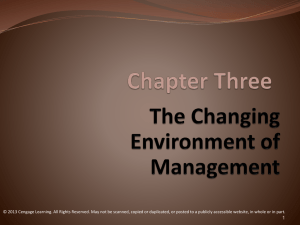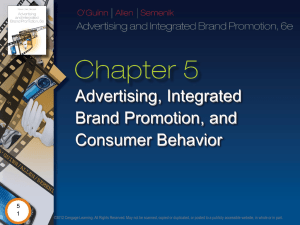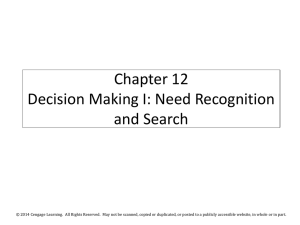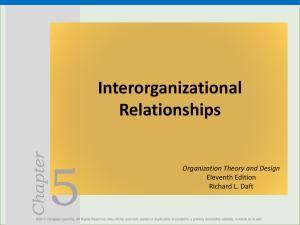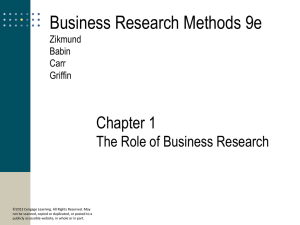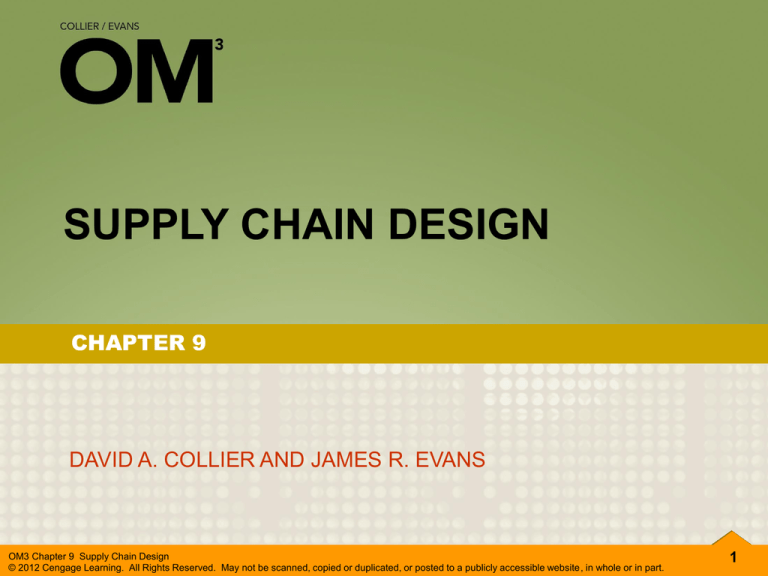
SUPPLY CHAIN DESIGN
CHAPTER 9
DAVID A. COLLIER AND JAMES R. EVANS
OM3 Chapter 9 Supply Chain Design
© 2012 Cengage Learning. All Rights Reserved. May not be scanned, copied or duplicated, or posted to a publicly accessible website, in whole or in part.
1
CHAPTER 9
SUPPLY CHAIN DESIGN
LO1 Explain the concept of supply chain management.
LO2 Describe the key issues in designing supply chains.
LO3 Define metrics used in evaluating supply chain
performance.
LO4 Explain important factors and decisions in locating
facilities.
LO5 Describe the role of transportation, supplier
evaluation, technology, and inventory in supply
chain management.
OM3 Chapter 9 Supply Chain Design
© 2012 Cengage Learning. All Rights Reserved. May not be scanned, copied or duplicated, or posted to a publicly accessible website, in whole or in part.
2
m
CHAPTER 9
SUPPLY CHAIN DESIGN
any of you have probably shopped at the Gap or its
other apparel stores, Old Navy or Banana Republic. The
supply chain at the Gap, Inc. begins at farms that grow raw
materials such as cotton. Textile mills then weave the raw
materials into fabrics for making T-shirts and jeans.
Factories then cut and sew the fabrics into finished goods,
which are then transported to retail stores for sale to
consumers. Supply chain management at Gap, Inc.
includes the functions of Strategy, Network Logistics, Global
Production & Planning, Sourcing & Vendor Development
and Sourcing Services. For the Gap and many other
clothing manufacturers, the supply chain has significant
implications for social responsibility and sustainability.
OM3 Chapter 9 Supply Chain Design
© 2012 Cengage Learning. All Rights Reserved. May not be scanned, copied or duplicated, or posted to a publicly accessible website, in whole or in part.
3
CHAPTER 9
SUPPLY CHAIN DESIGN
As the Gap notes: “As with most other companies that sell
apparel, we don’t own the garment factories that make our
clothes. But we do share responsibility for the conditions
under which our clothes are made. Our commitment to
safe and fair working conditions extends beyond our
employees and stores to include the partners in our supply
chain. We know from firsthand experience that our efforts
to improve the lives of people who work on behalf of our
company help us run a more successful business. People
who work a reasonable number of hours in a safe and
healthy environment not only have a better quality of life,
but they also tend to be more productive and deliver
higher-quality product than those who work in poor
conditions.”
OM3 Chapter 9 Supply Chain Design
© 2012 Cengage Learning. All Rights Reserved. May not be scanned, copied or duplicated, or posted to a publicly accessible website, in whole or in part.
4
CHAPTER 9
SUPPLY CHAIN DESIGN
What do you think?
What percent of the clothes in
your closet do you think are
produced in other countries?
What do you think the
structure of the manufacturers’
supply chains look like? Do
clothing firms have a
responsibility to improve work
conditions and sustainability
practices wherever they do
business?
OM3 Chapter 9 Supply Chain Design
© 2012 Cengage Learning. All Rights Reserved. May not be scanned, copied or duplicated, or posted to a publicly accessible website, in whole or in part.
5
CHAPTER 9
SUPPLY CHAIN DESIGN
Understanding Supply Chains
• A supply chain is a key subsystem of a value chain
that focuses primarily on the physical movement of
goods and materials along with supporting
information through the supply, production, and
distribution processes.
• Key Functions: Purchasing and procurement of
materials and supplies, sales and order processing,
operations, inventory and materials management,
transportation and distribution, information
management, finance, and customer service.
OM3 Chapter 9 Supply Chain Design
© 2012 Cengage Learning. All Rights Reserved. May not be scanned, copied or duplicated, or posted to a publicly accessible website, in whole or in part.
6
CHAPTER 9
SUPPLY CHAIN DESIGN
Understanding Supply Chains
• Distribution centers (DCs) are warehouses
that act as intermediaries between factories and
customers, shipping directly to customers or to
retail stores where products are made available
to customers.
• Inventory refers to raw materials, work-in-
process, or finished goods that are maintained to
support production or satisfy customer demand.
OM3 Chapter 9 Supply Chain Design
© 2012 Cengage Learning. All Rights Reserved. May not be scanned, copied or duplicated, or posted to a publicly accessible website, in whole or in part.
7
CHAPTER 9
SUPPLY CHAIN DESIGN
Exhibit 9.1
Typical GoodsProducing
Supply Chain
Structure
OM3 Chapter 9 Supply Chain Design
© 2012 Cengage Learning. All Rights Reserved. May not be scanned, copied or duplicated, or posted to a publicly accessible website, in whole or in part.
8
CHAPTER 9
SUPPLY CHAIN DESIGN
Understanding Supply Chains
• Supply chain management (SCM) is the
management of all activities that facilitate the
fulfillment of a customer order for a
manufactured good to achieve satisfied
customers at a reasonable cost.
OM3 Chapter 9 Supply Chain Design
© 2012 Cengage Learning. All Rights Reserved. May not be scanned, copied or duplicated, or posted to a publicly accessible website, in whole or in part.
9
CHAPTER 9
SUPPLY CHAIN DESIGN
The Supply Chain Operations Reference (SCOR)
Model is a framework for understanding the scope of
SCM based on five basic functions:
1. Plan: Developing a strategy that balances resources
2.
3.
4.
5.
with requirements.
Source: Procuring goods and services to meet
planned or actual demand.
Make: Transforming goods and services to a
finished state to meet demand.
Deliver: Managing orders, transportation, and
distribution to provide the goods and services.
Return: Customer returns, maintenance, dealing
with excess goods.
OM3 Chapter 9 Supply Chain Design
© 2012 Cengage Learning. All Rights Reserved. May not be scanned, copied or duplicated, or posted to a publicly accessible website, in whole or in part.
10
CHAPTER 9
SUPPLY CHAIN DESIGN
OM3 Chapter 9 Supply Chain Design
© 2012 Cengage Learning. All Rights Reserved. May not be scanned, copied or duplicated, or posted to a publicly accessible website, in whole or in part.
11
CHAPTER 9
SUPPLY CHAIN DESIGN
The Supply Chain at Dell
• Purchasing and supplier partnerships:
Keyboards are sourced in Mexico, soundcards in
France, and power supplies, disk drives, and chips in
Asia.
• Dell pulls component parts into its factories based on
actual customer orders and carries no finished goods
inventory, relying on information technology to drive
its supply chain.
• Sustainability is a key part of Dell’s supply chain:
Renewable energy use, recycling, and integration of a
sustainability strategy.
OM3 Chapter 9 Supply Chain Design
© 2012 Cengage Learning. All Rights Reserved. May not be scanned, copied or duplicated, or posted to a publicly accessible website, in whole or in part.
12
CHAPTER 9
SUPPLY CHAIN DESIGN
The Supply Chain at Dell
• IT Infrastructure using an Oracle database
supports Dell’s supply chain.
• Key modules:
Configuration management
Procurement
Cost Management
Inventory
Accounts payable
OM3 Chapter 9 Supply Chain Design
© 2012 Cengage Learning. All Rights Reserved. May not be scanned, copied or duplicated, or posted to a publicly accessible website, in whole or in part.
13
CHAPTER 9
SUPPLY CHAIN DESIGN
Designing the Supply Chain
• A contract manufacturer is a firm that specializes
in certain types of goods-producing activities, such as
customized design, manufacturing, assembly, and
packaging, and works under contract for end users.
• Advantages of using contract manufacturing:
Access to advanced manufacturing technologies
Faster product time-to-market
Customization of goods in regional markets
Lower total costs resulting from economies of
scale
OM3 Chapter 9 Supply Chain Design
© 2012 Cengage Learning. All Rights Reserved. May not be scanned, copied or duplicated, or posted to a publicly accessible website, in whole or in part.
14
CHAPTER 9
SUPPLY CHAIN DESIGN
Designing the Supply Chain
• Efficient supply chains are designed for
efficiency and low cost by minimizing inventory
and maximizing efficiencies in process flow.
Examples: Wal-Mart and Proctor & Gamble.
• Responsive supply chains focus on flexibility
and responsive service and are able to react
quickly to changing market demand and
requirements. Examples: Nordstrom’s and
Apple.
OM3 Chapter 9 Supply Chain Design
© 2012 Cengage Learning. All Rights Reserved. May not be scanned, copied or duplicated, or posted to a publicly accessible website, in whole or in part.
15
CHAPTER 9
SUPPLY CHAIN DESIGN
Designing the Supply Chain
• A push system produces goods in advance of
customer demand using a forecast of sales and
moves them through supply chain to points of
sale where they are stored as finished goods
inventory.
• A pull system produces only what is needed at
upstream stages in the supply chain in response
to customer demand signals from downstream
stages.
OM3 Chapter 9 Supply Chain Design
© 2012 Cengage Learning. All Rights Reserved. May not be scanned, copied or duplicated, or posted to a publicly accessible website, in whole or in part.
16
CHAPTER 9
SUPPLY CHAIN DESIGN
Exhibit 9.2 Supply Chain Push-Pull Systems and Boundaries
OM3 Chapter 9 Supply Chain Design
© 2012 Cengage Learning. All Rights Reserved. May not be scanned, copied or duplicated, or posted to a publicly accessible website, in whole or in part.
17
CHAPTER 9
SUPPLY CHAIN DESIGN
Designing the Supply Chain
• Postponement is the process of delaying
product customization until the product is closer
to the customer at the end of the supply chain.
• Example: A manufacturer of dishwashers that
would manufacture the dishwasher without the
door and maintain inventories of doors at the
distribution centers. When orders arrive, the
doors can be attached quickly and the unit can be
shipped. This would reduce inventory
requirements.
OM3 Chapter 9 Supply Chain Design
© 2012 Cengage Learning. All Rights Reserved. May not be scanned, copied or duplicated, or posted to a publicly accessible website, in whole or in part.
18
CHAPTER 9
SUPPLY CHAIN DESIGN
OM3 Chapter 9 Supply Chain Design
© 2012 Cengage Learning. All Rights Reserved. May not be scanned, copied or duplicated, or posted to a publicly accessible website, in whole or in part.
19
CHAPTER 9
SUPPLY CHAIN DESIGN
Sustainable Supply Chains
• A green sustainable supply chain can be
defined as "the process of using environmentally
friendly inputs and transforming these inputs
through change agents—whose byproducts can
improve or be recycled within the existing
environment.”
OM3 Chapter 9 Supply Chain Design
© 2012 Cengage Learning. All Rights Reserved. May not be scanned, copied or duplicated, or posted to a publicly accessible website, in whole or in part.
20
CHAPTER 9
SUPPLY CHAIN DESIGN
Sustainable Supply Chains
Environmental performance-enhancing supply chain
management activities:
•
•
•
•
•
•
•
•
Substantially decreasing scrap, packaging, and material losses.
Adopting paperless practices for information processing.
Lowering expenses associated with hazardous materials.
Increasing revenues by converting wastes to by-products.
Reducing water and energy requirements.
Decreasing the use and waste of solvents, paints, cleaning
fluids, and other chemicals.
Selecting suppliers that support sustainability.
Recovering valuable materials and assets through efficient
product take-back and recycle programs.
OM3 Chapter 9 Supply Chain Design
© 2012 Cengage Learning. All Rights Reserved. May not be scanned, copied or duplicated, or posted to a publicly accessible website, in whole or in part.
21
CHAPTER 9
SUPPLY CHAIN DESIGN
Sustainable Supply Chains
“Our data indicates that upwards
of 60 to 70 percent of a company’s
carbon footprint is found along
their supply chain,”
says Ms. Annie Berger,
Relationships Director of greensupplychain.org.
OM3 Chapter 9 Supply Chain Design
© 2012 Cengage Learning. All Rights Reserved. May not be scanned, copied or duplicated, or posted to a publicly accessible website, in whole or in part.
22
CHAPTER 9
SUPPLY CHAIN DESIGN
Sustainable Supply Chains
• Manufactured good recovery:
Reuse or resell
Repair
Refurbish
Remanufacture
Cannibalize parts
Recycle goods
Incineration or landfill disposal
OM3 Chapter 9 Supply Chain Design
© 2012 Cengage Learning. All Rights Reserved. May not be scanned, copied or duplicated, or posted to a publicly accessible website, in whole or in part.
23
CHAPTER 9
SUPPLY CHAIN DESIGN
Sustainable Supply Chains
• Reverse logistics refers to managing the flow
of finished goods, materials, or components that
may be unusable or discarded through the
supply chain from customers toward either
suppliers, distributors or manufacturers for the
purpose of reuse, resale, or disposal.
OM3 Chapter 9 Supply Chain Design
© 2012 Cengage Learning. All Rights Reserved. May not be scanned, copied or duplicated, or posted to a publicly accessible website, in whole or in part.
24
CHAPTER 9
SUPPLY CHAIN DESIGN
Exhibit 9.3 Example of a Manufactured Good Recovery (Reverse Logistics)
Supply Chain
OM3 Chapter 9 Supply Chain Design
© 2012 Cengage Learning. All Rights Reserved. May not be scanned, copied or duplicated, or posted to a publicly accessible website, in whole or in part.
25
CHAPTER 9
SUPPLY CHAIN DESIGN
Measuring Supply Chain Performance
•
•
Delivery reliability, such as perfect order fulfillment.
Responsiveness, such as order fulfillment lead time or
•
Customer-related measures focus on the ability of the
•
•
•
perfect delivery fulfillment.
supply chain to meet customer wants and needs.
Supply chain efficiency measures, such as average
inventory value and inventory turnover.
Sustainability measures, such as water discharge, CO2
emissions, and energy reductions.
Financial measures, such as total supply chain costs
and costs of processing returns and warranties.
OM3 Chapter 9 Supply Chain Design
© 2012 Cengage Learning. All Rights Reserved. May not be scanned, copied or duplicated, or posted to a publicly accessible website, in whole or in part.
26
CHAPTER 9
SUPPLY CHAIN DESIGN
Exhibit 9.4 Common Metrics Used to Measure Supply Chain Performance
OM3 Chapter 9 Supply Chain Design
© 2012 Cengage Learning. All Rights Reserved. May not be scanned, copied or duplicated, or posted to a publicly accessible website, in whole or in part.
27
CHAPTER 9
SUPPLY CHAIN DESIGN
Measuring Supply Chain Performance
• The bullwhip effect results from order
amplification in the supply chain: a
phenomenon that occurs when each member
of a supply chain “orders up” to buffer its own
inventory.
• Many firms counteract this phenomenon by
using common data from the point of the
supply chain closest to the customer, smaller
order sizes, stabilizing price fluctuations, and
sharing information.
OM3 Chapter 9 Supply Chain Design
© 2012 Cengage Learning. All Rights Reserved. May not be scanned, copied or duplicated, or posted to a publicly accessible website, in whole or in part.
28
CHAPTER 9
SUPPLY CHAIN DESIGN
Location Decisions in Value Chains
• Location decisions can have a profound effect on
supply chain performance and a firms’
competitive advantage.
• The type of facility and its location affect the
supply chain structure.
• Location decisions in value chains are based on:
Economic (facility costs, operating costs, and
transportation costs)
Non-economic (labor availability, legal and political
factors, community environment) factors
OM3 Chapter 9 Supply Chain Design
© 2012 Cengage Learning. All Rights Reserved. May not be scanned, copied or duplicated, or posted to a publicly accessible website, in whole or in part.
29
CHAPTER 9
SUPPLY CHAIN DESIGN
Exhibit 9.5 Example Location Factors for Site Selection
OM3 Chapter 9 Supply Chain Design
© 2012 Cengage Learning. All Rights Reserved. May not be scanned, copied or duplicated, or posted to a publicly accessible website, in whole or in part.
30
CHAPTER 9
SUPPLY CHAIN DESIGN
Location Decisions in Value Chains
Location Decision Process:
• Global location
• Regional location
• Community location
• Local site location
OM3 Chapter 9 Supply Chain Design
© 2012 Cengage Learning. All Rights Reserved. May not be scanned, copied or duplicated, or posted to a publicly accessible website, in whole or in part.
31
CHAPTER 9
SUPPLY CHAIN DESIGN
Center of Gravity Method
• The center of gravity method determines
the X and Y coordinates (location) for a single
facility.
Takes into account locations, demand, and
transportation costs to arrive at the best
location.
OM3 Chapter 9 Supply Chain Design
© 2012 Cengage Learning. All Rights Reserved. May not be scanned, copied or duplicated, or posted to a publicly accessible website, in whole or in part.
32
CHAPTER 9
:
SUPPLY CHAIN DESIGN
Solved Problem
Exhibit 9.6 Taylor Paper Products Plant and Customer Locations
OM3 Chapter 9 Supply Chain Design
© 2012 Cengage Learning. All Rights Reserved. May not be scanned, copied or duplicated, or posted to a publicly accessible website, in whole or in part.
33
CHAPTER 9
SUPPLY CHAIN DESIGN
Solution
Exhibit Extra Excel Spreadsheet for Taylor Paper Products
OM3 Chapter 9 Supply Chain Design
© 2012 Cengage Learning. All Rights Reserved. May not be scanned, copied or duplicated, or posted to a publicly accessible website, in whole or in part.
34
CHAPTER 9
SUPPLY CHAIN DESIGN
Solution: Center of Gravity Calculations
Cx =
58(400) + 80(300) + 30(200) + 90(100) + 127(300) + 65(100)
Cy =
96(400)+70(300)+120(200)+110(100)+130(300)+40(100)
400 + 300 + 200 + 100 + 300 + 100
400 + 300 + 200 + 100 + 300 + 100
OM3 Chapter 9 Supply Chain Design
© 2012 Cengage Learning. All Rights Reserved. May not be scanned, copied or duplicated, or posted to a publicly accessible website, in whole or in part.
= 76.3
= 98.1
35
CHAPTER 9
SUPPLY CHAIN DESIGN
Other Issues in Supply Chain Management
• Selecting transportation services
• Supplier evaluation
• Technology
• Inventory management
OM3 Chapter 9 Supply Chain Design
© 2012 Cengage Learning. All Rights Reserved. May not be scanned, copied or duplicated, or posted to a publicly accessible website, in whole or in part.
36
CHAPTER 9
SUPPLY CHAIN DESIGN
Other Issues in Supply Chain Management
• Vendor managed inventory (VMI) is where
the vendor (a consumer goods manufacturer, for
example) monitors and manages the inventory
for the customer (a grocery store, for example).
Advantages: Optimize production operations,
better control inventory and capacity, and
reduce total supply chain costs and the
bullwhip effect.
Disadvantages: Often results in higher than
necessary customer inventories.
OM3 Chapter 9 Supply Chain Design
© 2012 Cengage Learning. All Rights Reserved. May not be scanned, copied or duplicated, or posted to a publicly accessible website, in whole or in part.
37
CHAPTER 9
SUPPLY CHAIN DESIGN
Boston Red Sox Spring Training Decision Case
Study
1. Using the center-of-gravity model compute the
center of gravity for the population of the county?
Show all computations, explain, and justify. Based
solely on this criterion where is the best stadium
location?
2. Using a weighted scoring model of your own
design what are the summary scores for each
stadium site for the qualitative criteria in Exhibit
9.8. Show all computations, explain, and justify.
OM3 Chapter 9 Supply Chain Design
© 2012 Cengage Learning. All Rights Reserved. May not be scanned, copied or duplicated, or posted to a publicly accessible website, in whole or in part.
38
CHAPTER 9
SUPPLY CHAIN DESIGN
Boston Red Sox Spring Training Decision Case
Study
3. How will you combine these results—your center-ofgravity results, cost, and qualitative criteria analyses?
How might you compute a summary score for each site
using all three criteria? Explain and justify.
4. Research and explain at least three ways a sports stadium
can “go green” including at least one work practice for
stadium employees. Do jobs and processes have to
change too? Explain the role of OM.
5. What is your final stadium recommendations? Explain
and justify.
OM3 Chapter 9 Supply Chain Design
© 2012 Cengage Learning. All Rights Reserved. May not be scanned, copied or duplicated, or posted to a publicly accessible website, in whole or in part.
39



